

They also relied on the Sturmgeschütz III, a medium self-propelled assault gun used not only in the Battle of Kursk, but from 1940 until the end of the Second World War. The tank began service in 1942 and saw much use during Kursk, and through until the end of World War Two.Īround 246 Tigers were supplied to troops during the battle. Image: German Federal ArchiveĪnother vehicle used by Germany was the Panzerkampfwagen VI a heavy tank known as the 'Tiger'. A damaged Panzerjäger Tiger, during 1944 in Italy.

They were designed to destroy long-range targets, with an operational range of 90 km. One such vehicle was the Panzerjäger Tiger, known as the 'Elefant' and the 'Ferdinand'.īuilt in 1943, the self-propelled artillery vehicle was one of the top tanks used by Germany at the time and made their first appearances during the Battle of Kursk. Germany brought nearly 3,000 tanks with them, and while the Soviet Union had nearly double that figure, the German's were considered to possess better firepower. What hardware did both sides take into battle? The German's codenamed 'Operation Citadel' was met by two Soviet counter offensives, in a battle that lasted for well over a month.Īlmost 3,000,000 troops and thousands of tanks were involved in the battle, ending with a Soviet victory, following a decision by Adolf Hitler to call off the German offensive. It is 74 years to the day since one of the largest tank battles in military history - the Battle of Kursk.ĭuring the Second World War, Germany launched an ultimately unsuccessful offensive against the Soviet Union on the Eastern Front. Soviet 5 Tank Corps and 11 Guards Rifle Division counter-attack the Germans on J(image from ‘Kursk 1943: The Northern Front’ by Robert Forczyk © Osprey Publishing, part of Bloomsbury Publishing)


 0 kommentar(er)
0 kommentar(er)
